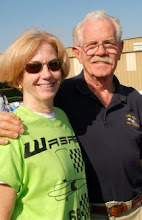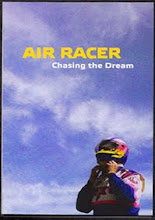
We took off as a flight of two from Mojave at 8:00. Justin used the opportunity to practice a
pickup with the GT operating as a surrogate.
It took 15" MAP and 2500 RPM on the GT for the Tango to hang with
the GT, both burning about 11.5 GPH. We
arrived at Apple Valley at 8:45. There
were three airplanes in the pattern including a taildragger without a radio.
We worked until 11:30 checking the airframe and engine
compartment. There were some concerns
with the inboard aileron hinges pulling off the surface, and similarly with the
rudder trim tab (bellcrank moving relative to the surface). The result was that there was some play in
the rudder tab, that play was on the order of what we found in the
elevator. We found that the aileron trim
tab was operating backwards, Hadlich fixed that. Right before lunch we were looking at the
parking brake and found it to be engaged, so Elliot turned it off and we went
to lunch. Lunch took about 30 minutes at
the airport restaurant.
After Lunch when we got back to the hangar we found a puddle
of brake fluid under the airplane and an associated brake fluid trail on the
right side of the pilot's foot well.
Tracing the leak Justin found it was the parking brake that was
leaking. Justin worked the problem first
confirming the brake lines were tight, they were. So Justin checked that the brake housing was
tight, it was. He finally removed the
parking brake and replaced it with a AN3 male to male fitting. We bled the left brake and found both left
and right brakes to be tight. We
installed the cowlings and performed an engine run and taxi test. The brakes functioned fine during the taxi
test. During the engine run I check the
mags and cycled the prop all functioned as expected. Peak CHT 330F, and peak oil 150F, oil
pressure was stable at 55 PSI. Number 5
cylinder CHT was not funcitonal. We left
to fly back to Mojave at 2:45, arriving in Mojave at 3:30, done for the day at
4:15.
Sunday started with a 6:30 show at Mojave airport, we packed
the airplane and launched at 7:00 for a 7:45 arrival at Apple valley. We briefed at 8:10 and stepped at 8:30. During the engine start I used high boost to
prime and cranked, the engine popped twice and then died, I didn't release the
starter and then selected high boost.
After another 6 or 8 blades the engine caught and ran fine. Initial oil pressure 55 PSI. During the taxi out we did radio checks,
there were some issues with the ground comm, that I think were mostly a
miscommunication about what frequency the test team was on. In order to improve line of sight issues that
may have been the cause of the radio problems Justin launched in the Tango and
was therefore able to help with the comms.
Engine run up went well, with very small (<50 drops="" fuel="" mag="" pressure="">27 PSI, oil pressure 40 PSi (which is at the bottom
limit). Through the whole morning the
traffic on the airport was steadily increasing. An interesting go-no go item of how much traffic is too much
traffic for this kind of testing.
I took the runway while Justin was on initial. He called 30 seconds and 10 seconds, then an
airplane made a relatively long call about being 10 miles south of the
field. Justin called brake release right
at the end of this transmission. I
applied full power and released the brakes, my first priority was to confirm
with more RPM the oil pressure got further into the green. Once I saw 45 PSI, I checked that the
airspeed was functioning, I saw 40 KIAS.
I then checked the engine RPM and fuel pressures. By the time I looked back at the airspeed I
saw 60 KIAS, and I added back pressure to check pitch handling, With back pressure the airplane came up on to
the mains I held it there until 85 KIAS when the airplane naturally rose off
the ground. I selected gear up and
turned to offset to the left 15 degrees.
As I turned left there was a significant engine sound change, I decided
this was related to the pneumatic canopy seal.
I accelerated to 120 for climb speed and looked left
noticing the left fuel cap was venting a lot, then the gear finished transit
and the pump turned off. I started a
right hand turn, Justin called "clean and dry" and I noticed a
"Warm smell" in the cockpit. I
called the smell and venting fuel cap over the radio. As I crossed over the center of the field I
had reached my 180 degree dirty turn altitude of 4500' MSL. I switched from the right tank to the left
tank to try to limit the fuel venting.
Justin called that based on the traffic to the south that we keep the
climb going. So I reduced to climb power
(WOT and 2500 RPM) holding 120 KIAS through 7000' MSL. During that climb I leaned the mixture
(initially flowing >32GPH at 25" MAP and all EGTs below the scale, CHTs
in the 300s), I leaned to the mid 1300s which took two or three turns. As I climbed from 7K' to 8K' I accelerated to
VA. At 8K and 170 I reduced power to
hold altitude. Based on Justin's
suggestion I did three axis stick wraps at 170 KIAS with no airframe
response. The ailerons seemed softer
than Race 44, but I hardly ever fly 44 at VA.
With 15 degrees of roll in a left hand orbit at 8,000 feet
and partial power. Just asked for a
situation report on the engine. I
checked as such and the #6 cylinder was up to 418 degrees, so I added a full
turn of mixture. The CHT responded and
cooled quickly. Oil temp was 220f but
Oil Pressure was down to 35. With a
minimum oil pressure of 40 PSI this was below the limit. As a result we called the flight. I slowed to 140 and extended the gear (which
clears the gear envelope). I slowed to
110 KIAS and extended the flaps to the stop, no roll asymmetry resulted. I then retracted the flaps and the gear to
give us more options as we waited for traffic at the airport to clear.
I arrived at high-key at 140 and 5,500, and extended the
flaps to 10 degrees. The left fuel cap
started venting again abou tthis time.
At low key the airplane was low and not far enough downwind. I was very concerned about the short runway
so I decided to extend the downwind. In
order to do that I pull the propeller back to decrease drag and slowed to 110
KIAS. As I rolled on to base and final I
held 110. I held 110 into the pre flare,
as a result during the flare I got below 100 (with ten degrees of flaps) and as
a result I was pretty blind (nose was very high). Luckily Justin was right there with the
altitude calls, and the landing went well.
As I was rolling out with the nose up just on the mains I checked the
brakes and they were totally flat. It
took two or three pumps to get the brakes to work but they seemed to function
normally after that. I set the nose down
with less than 2000 feet remaining and ended up taking the last taxi way.
Looking the airplane over after the flight the main gear
oleos had some oil visible on the strut, not suprising but they seemed to be
functioning properly.
We went to get food at 9:30.
Elliot and Justin flew back to Mojave and were on deck with the
airplanes stowed by 11:30.
Engine Start 8:49
Engine Shutdown: 9:09
Sqwawks:
Fuel Vent Left Side
Oil Pressure Regulator
#6 Cylinder Hot
#5 CHT not functioning
Brakes need to be bled.





















